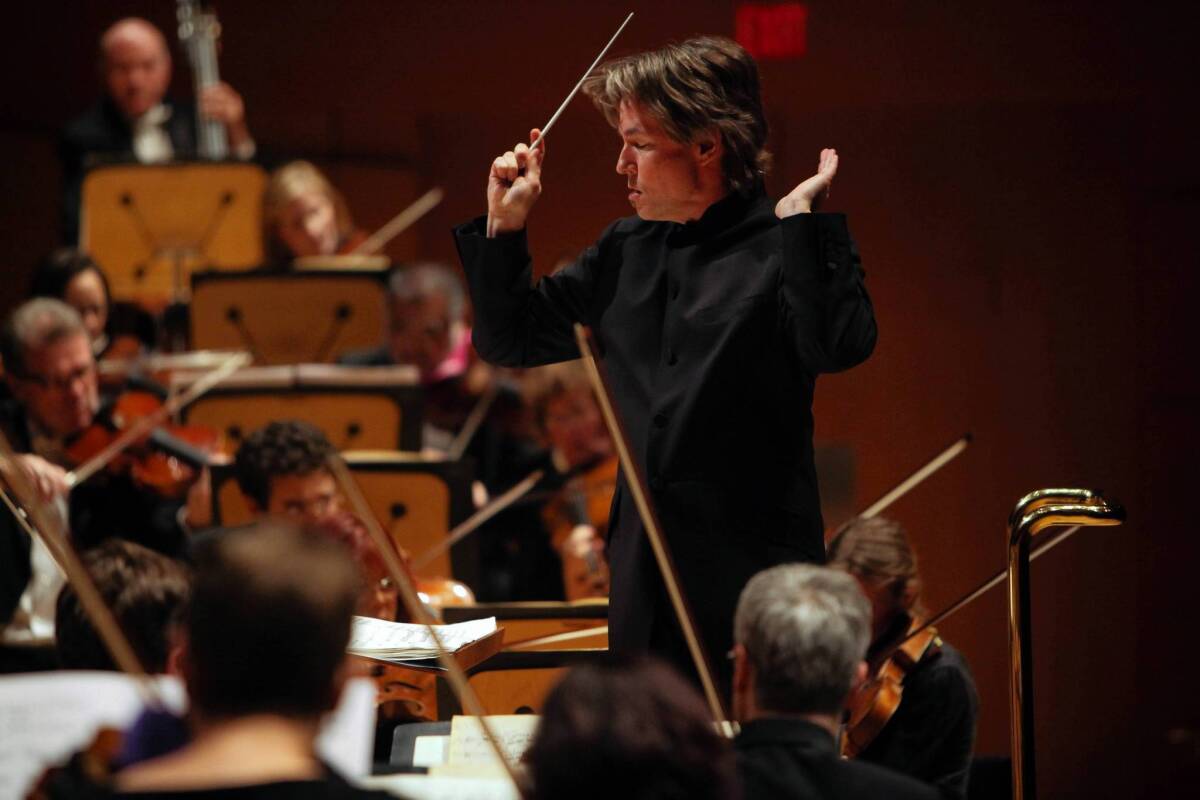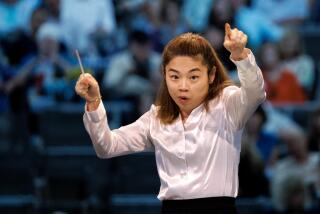Review: Esa-Pekka Salonen and an electrifying L.A. Philharmonic

The Los Angeles Philharmonic did not become an international leader of orchestras by succumbing to sentimentality. Where other ensembles become fixated on major composers’ anniversaries, Angelenos were lucky to get a nod for, say, the bicentennial of Liszt’s birth last year.
But Witold Lutoslawski is an exception. The eloquent and reservedly revolutionary Polish composer who would have turned 100 next month had a noteworthy relationship with the L.A. Phil. He conducted it regularly during the last decade of his life. His last major work, the Fourth Symphony, was an L.A. Phil commission, and the composer premiered it here in 1993, a year before he died.
L.A. Phil conductor laureate Esa-Pekka Salonen, who returned Friday to Walt Disney Concert Hall for his annual late fall two-week residency with his former orchestra, idolized Luto, as the composer is affectionately called. For his U.S. debut in 1984, the 26-year-old Salonen conducted the L.A. Phil in Lutoslawski’s Third Symphony. The following year, they recorded the work and took home a Grammy. Salonen also went on to record the Second and, on two occasions, the Fourth in L.A. They’re the performances to have.
PHOTOS: Arts and culture in pictures by The Times
Clearly some emotion had to mark Salonen’s return. He is adding to that collection Lutoslawski’s early, neglected First Symphony (which was recorded live during the weekend concerts and will be released early next year by Sony Classics as part of a Salonen/L.A. Phil Lutoslawski symphony set). More Lutoslawski, moreover, will be part of Tuesday’s Green Umbrella program and Salonen’s remaining weekend concerts.
Even so, sentiment was not part of the equation Friday. Salonen’s inspiration, instead, was to pair the Lutoslawski First with an electrifying, high-spirited performance of Beethoven’s youthful Second Symphony.
Lutoslawski’s is a wartime score, written between 1941 and 1947, hard years for all Poles and particularly so for the composer. Captured by the Germans, he escaped and walked 250 miles back to Warsaw. His brother perished in a Russian labor camp.
That the symphony begins with what sounds like a cri de coeur is almost to be expected. But the first movement’s jaunty first theme that follows the eruption is not. It is as though a prison gate has been blasted open and we’re off on a great adventure. The war years were terrible, but life was still lived. Lutoslawski was young. He fell in love. And he found his musical voice. His talent burst forth.
Salonen made that sense of urgency palpable. The symphony can be seen as Lutoslawski capturing stylistic influences (Bartók, Stravinsky and maybe Milhaud) and finding his own way with them.
But more interesting are the sudden shifts of tone, which Salonen focused on. The slow movement, with its eloquent horn solo (beautifully played by Andrew Bain), erupts into grotesque weirdness. Salonen gave the Scherzo a kind of ghoulish humor that is not so funny when the orchestra explodes, as though a bomb has been dropped on the dance hall.
Most extraordinary of all was the end. The somewhat conventional frenzy of the Finale gets demolished by a bigger-still orchestral bomb, and then atmosphere clears into a vision of wonder. Have we died and gone to heaven? Or have we merely wiped out the enemy and now the battlefields are Elysian?
Lutoslawski’s First Symphony was the culmination of the composer’s first period and set the stage for his real breakthrough, his Concerto for Orchestra in 1954. Beethoven’s Second, likewise, was the work leading up to his breakthrough “Eroica” Symphony. Salonen’s revelation was making the connections across a couple of centuries, bringing out the inner pulse of Beethoven’s score and its rhythmic audacity.
There were more connections. The Lutoslawski symphony was introduced by Beethoven’s late “King Stephen” Overture, which begins with a call to attention followed by a jaunty theme that goes places you’d never expect. Salonen introduced Beethoven’s symphony with Lutoslawski’s 1993 “Fanfare for Los Angeles Philharmonic,” another example of an old man full of fire.
The L.A. Phil has several new players since 2009, when Salonen gave up his music directorship. But Friday it was his orchestra once more, electrifying in sound and astonishingly able to turn on a dime.
MORE
INTERACTIVE: Christopher Hawthorne’s On the Boulevards
TIMELINE: John Cage’s Los Angeles
PHOTOS: Arts and culture in pictures
More to Read
The biggest entertainment stories
Get our big stories about Hollywood, film, television, music, arts, culture and more right in your inbox as soon as they publish.
You may occasionally receive promotional content from the Los Angeles Times.











